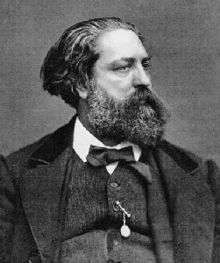Gustave Aimard

Gustave Aimard (13 September 1818[1] – 20 June 1883) was the author of numerous books about Latin America.
Aimard was born Olivier Aimard in Paris. As he once said, he was the son of two people who were married, "but not to each other". His father, François Sébastiani de la Porta (1775–1851) was a general in Napoleon’s army and one of the ambassadors of the Louis Philippe government. Sébastini was married to the Duchess de Coigny. In 1806 the couple produced a daughter: Alatrice-Rosalba Fanny. Shortly after her birth the mother died. Fanny was raised by her grandmother, the Duchess de Coigny. According to the New York Times of July 9, 1883, Aimard’s mother was Mme. de Faudoas, married to Anne Jean Marie René de Savary, Duke de Rovigo (1774–1833).
Aimard was given as a baby to a family that was paid to raise him. By the age of nine or twelve he was sent off on a herring ship. Later, around 1838, he served for a short while with the French Navy. After one more stay in America (where, according to himself, he was adopted into a Comanche tribe), Aimard returned to Paris in 1847-–the same year his half-sister, Duchess de Choiseul-Pralin, was brutally murdered by her noble husband. Reconciliation with, or acknowledgement by, his biological family did not happen. After having served for a short while at the Garde Mobil Aimard left again for the Americas. This time he was among the 150 miners hired by Duke de Raousset-Boulbon, who wanted to mine in Mexico. However, mining permits were not issued, and the duke decided ‘to free’ the poor people of Mexico. He conquered Hermosillo on October 13, 1852. The duke fell severely ill on the first night of his conquest, and the Hermosillo villagers right away re-took their village. The miners fled and Aimard again returned to France.
In 1854 he married to Adèle Lucie Damoreau, an ‘artiste lyrique’, and wrote about seventy books, many about them about American Indians. Most of his Indian books were translated into over ten languages. Their reviews mostly deal with the question whether they would harm children or not or whether they are too bloody or not. However, between the lines of his books many autobiographical, anthropological, and historical facts are hidden. Writing about the-–lost-–French-German war caused Aimard to lose his readership. His 1852 Mexican adventure is described in Curumilla; the history of the murder of his half-sister Fanny in Te Land en Te Water I & II.
In 1870 Aimard and a small army of press people participated in the French-German war in which he booked a modest success (the Bourget-affaire). In 1879 the literary community of Rio de Janeiro hailed him as a hero. Aimard’s travelogue about this journey has never been translated from French.
During his stay in Rio de Janeiro he had contact with Emperor Dom Pedro II of Brazil as is apparent from Aimard’s January 11, 1880 letter to Pedro II which letter he signed with Gustave Aimard.
References
- ↑ Aimard’s birth certificate states: Olivier Aimard – parents unknown. His death certificate states: Gustave Aimard – name mother Aimard; name father Sébastiani. That Aimard was just his pen-name, that his real name was Olivier Gloux, is a persistent error. Whether the name Aimard occurs in the Faudoas family is not yet known.
- Aimard, Gustave. 1860. Curumilla. Paris: Amyot.
- ––––1879. Par Terre et par Mer (Le Corsaire, Le Bâtard). Paris: Ollendorf.
- –––– 1888. Mon Dernier Voyage: Le Brésil Nouveau. 1888. Illustrée par Fernand Besnier. Paris: E. Dentu Éditeur. Libraire de la Société des gens de lettres.
- Eggermont-Molenaar. 2009. Gustave Aimard: Feiten, Frictie, Frictie. Calgary: Special Snowflake Inc.
- Sieverling, R. 1982. Die Abenteurromane Gustave Aimard's. Freiburg: Inaugural-Dissertation.
- Soulier, Maurice. [1856]1927. The Wolf Cub. The Great Adventure of Count Gaston de Raousset-Boulbon in California and Sonora – 1850-1854. Tr. by Farrell Symons. Indianapolis: The Bobbs-Merrill Company.
Sources
- Translated from nl:Gustave Aimard
External links
|